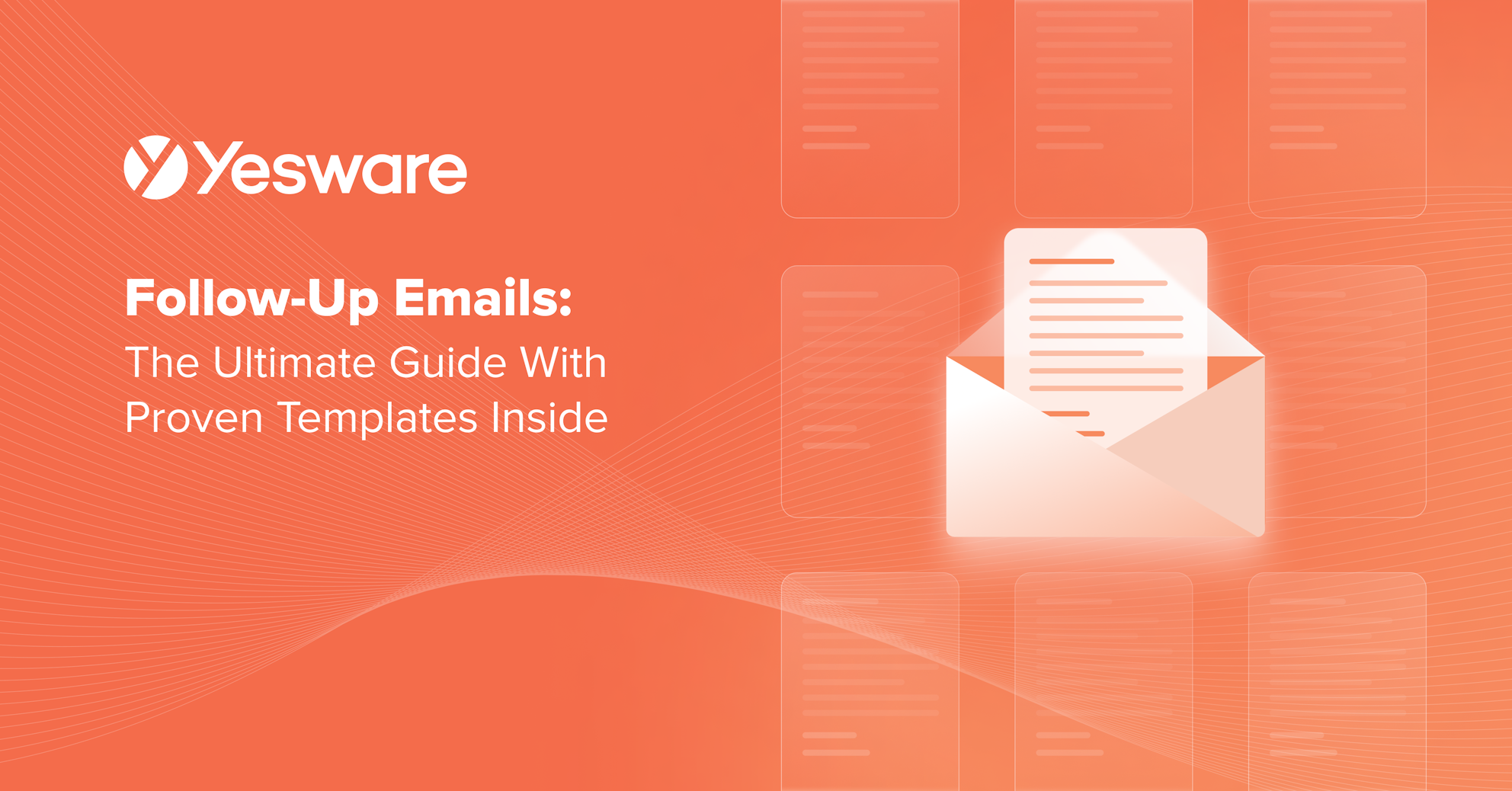17 Follow-Up Email Template Samples + Guide
Yesware
Follow-up emails are a secret weapon. Yet nearly half of sales reps don’t follow up at all.
If you do, you’ll reap the rewards. Sales reps who follow up consistently build better client relationships, close more deals, and become sales leaders in their company.
We’re all familiar with the art of “circling back” and “just checking in” when you never got a reply. But you don’t have a proven follow-up email template, so you hesitate before typing.
What can you say to get your prospects to write back?
Below are 17 follow-up email templates to copy and paste right now to use in your outreach. Included below are real-life examples, reply/response rates, and guides to writing effective follow-up emails.
Here’s what we’ll cover:
- Why Following Up Matters
- Follow-Up Email Templates
- How Do You Write a Follow-Up Email?
- Planning Your Follow-Up Sequence
- Optimizing Your Follow-Up Sequence
- Avoid These Mistakes When Writing a Follow-Up
- Sales Follow-Up Statistics
Why Following Up Matters
Most sales professionals know that following up can make an incredible difference, turning an email that goes unanswered into a productive conversation that leads to a close.
And yet even experienced sales pros still don’t do it nearly enough.
The numbers paint a bleak picture: 80% of sales deals take five or more follow-ups to close yet 44% of reps stop after the first attempt.
That means just 8% of sales reps are consistently following up with prospects. And if you’re among them, you’re putting yourself at an enormous competitive advantage.
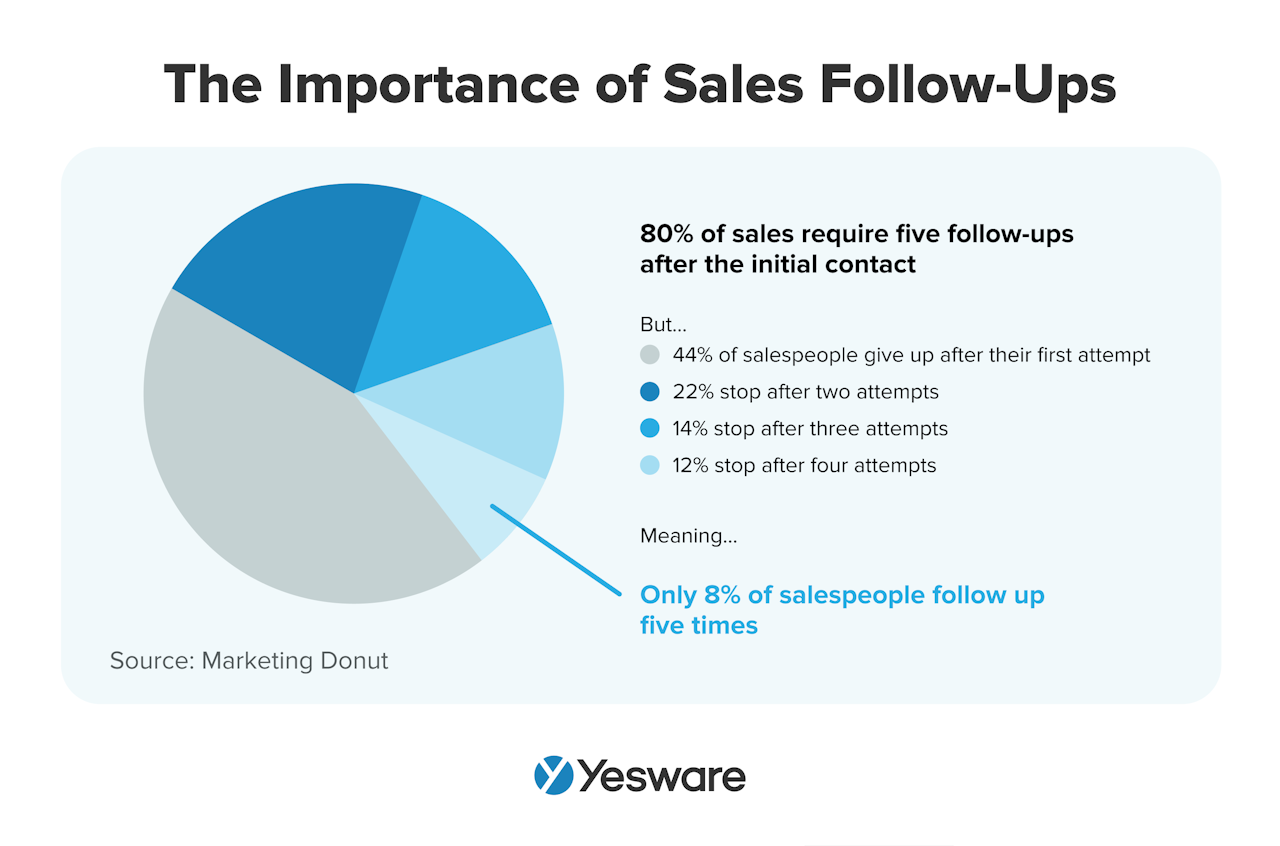 Having a strong follow-up game is essential if you want to position yourself among the top-performing reps landing most of the deals.
Having a strong follow-up game is essential if you want to position yourself among the top-performing reps landing most of the deals.
So why is it so hard to follow up? It’s all about mindset.
We don’t want to be annoying. And we all fear rejection. Those fears lead a lot of sales professionals to contact a prospect just once or perhaps send one follow-up. But that’s a sure route to a lousy close rate.
Top sales professionals understand that not hearing back from a prospect is totally normal.
That’s why being persistent is critical. The best approach is simple: keep following up on unanswered messages until you get a response.
If a prospect tells you it’s not a good time, you can simply respond and ask what a better time would be — and follow up then. And if a prospect does tell you they’re not interested, you can stop following up going forward.
Following up regularly takes commitment — but a strong, consistent follow-up game will put you in the elite group of sales reps who close the most deals.
Follow-Up Email Templates
1. The “Nice to Meet You” Follow-Up Email
When you have a mutual conversation with a stranger, it’s safe to assume they’ll welcome an email from you. So how do you write the “nice to meet you” email?
(Keyword: mutual)
For a fast follow-up, plug this information into a pre-set follow-up email template:
- How you met — Refreshes their memory
- A takeaway from your conversation — Shows you were listening
- Your ask — Keeps the ball moving
Here’s how to roll it all together:
Subject Line: Great to meet you at {!Event}
Hi {!First Name},
It was nice to meet you at {!Occasion where you met}. I loved learning more about {!Something discussed}. I’m really interested to hear more about your role as {!Job title} at {!Company name}, as {!Reason why you’re interested}.
If you have time in the coming weeks, let’s {!Follow up action}. I’m generally free on {!Days of the week}, if that works for you?
Looking forward to keeping in touch!
Tip: Suggest a time as a starting point, but keep your request flexible to give them control.
Give your recipient complete control by inserting a meeting scheduler link into your email that seamlessly integrates with your Outlook or Gmail calendar.
2. The Introduction Email
Someone just tapped on the network you’re so proud of, asking for an introduction email.
If they did it right, they made it easy for you by sending along all the necessary info.
This means you have a key insight already: the value that they plan to provide.
Below is a short follow up email that gets to the punch quickly:

Hint: Don’t forget to CC the person who requested the intro, so they can pick up the convo where you leave it off.
Copy and paste this follow-up email as a template to customize in seconds:
Hi {!First Name},
I hope this note finds you well and {!Personal note}.
{!Person requesting referral & their relation to you} (CC’d here) mentioned to me that {!he/she} is looking {!Reason for their request to you}. I’m reaching out in hopes that you can point {!him/her} in the right direction.
As I think you know, {!What requester’s company does}. {!Value statement — what’s in it for your recipient?}
Quick Favor
Might you be willing to introduce {!Requester’s first name} to the correct person who {!Responsibility} within {!Their Company}? It would be fantastic to {!Requester’s end vision}.Thank you in advance
3. When You Don’t Know Who the Decision-Maker Is – Ask for a Favor
Are you ever unsure whether you’re following up with the right person?
Your best move: Ask them to point you in the right direction.
This is a good way to build rapport and likability. When people provide assistance, it helps them feel good about themselves and their feeling toward you.
According to the psychology term called The Ben Franklin Effect: when we do someone a favor, we like them more.
Here’s a follow-up email template for this type of situation:
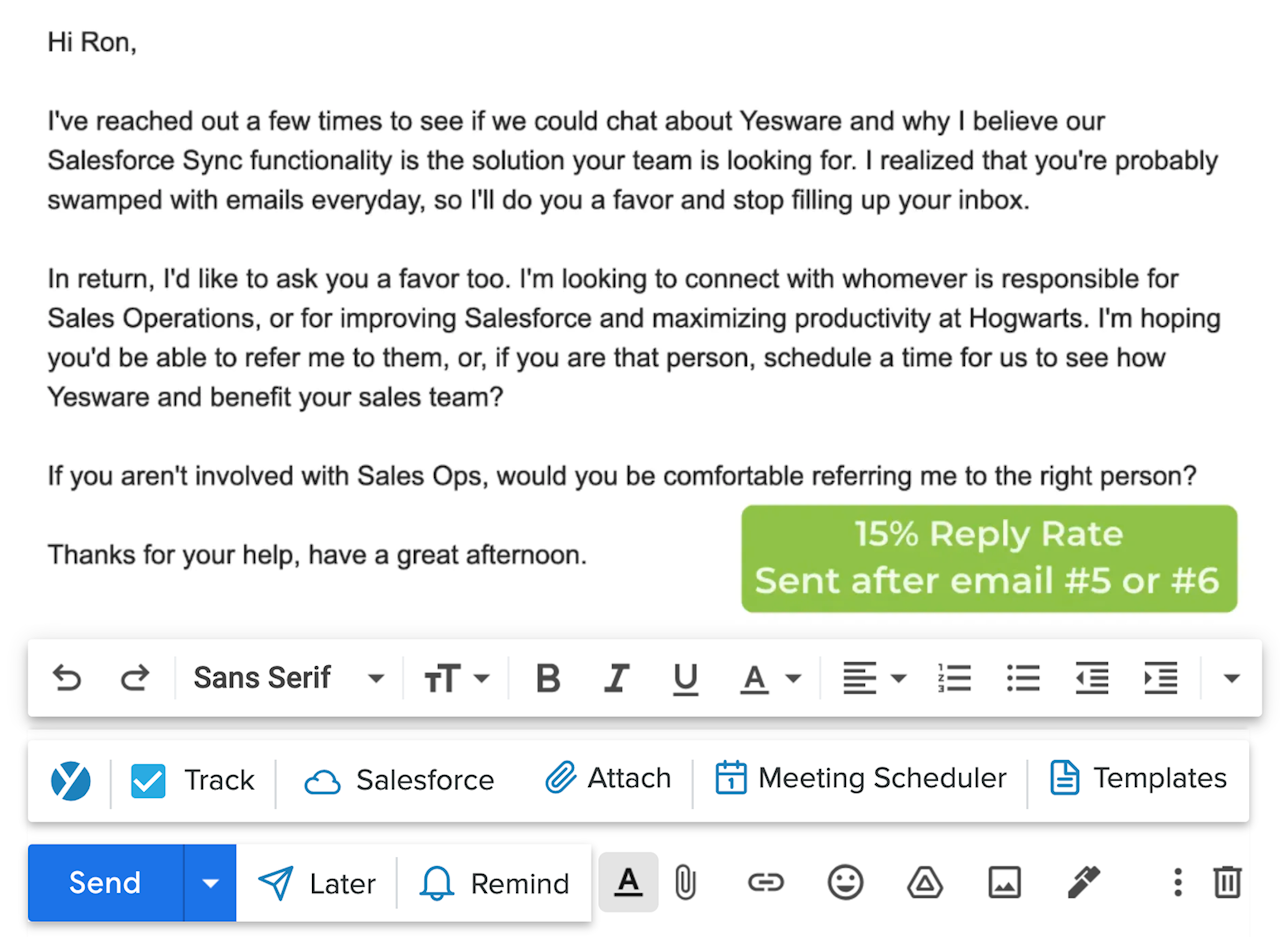
Here’s the template you can use today:
Hi {!First Name},
I’ve reached out a few times to see if we could chat about {!Product/Service} and why I believe our {!Feature/Functionality} is the solution your team is looking for. I realized that you’re probably swamped with emails every day, so I’ll do you a favor and stop filling up your inbox.
In return, I’d like to ask you a favor, too. I’m looking to connect with whoever is responsible for {!Role/Responsibilities} at {!Company}. I’m hoping you’d be able to refer me to them, or, if you are that person, schedule a time for us to see how {!Product/Service} can benefit your team?
If you aren’t involved with {!Department}, would you be comfortable referring me to the right person?
Thanks for your help and have a great day.
4. The “Just Left A Voicemail” Follow-Up Email
How many of your missed calls that go to voicemail are actually missed?
Chances are your prospect could be actively ignoring you (both your cold calls and cold emails).
Capturing their attention won’t be an easy feat — but it’s possible if you prove there’s alignment.
After you leave a voicemail message (voicemail and sales call scripts here), send an email to reiterate your value statement.
Like this:
Subject line: Just tried your line / next steps
Hey {!First Name},
I just left you a voicemail but wanted to drop a line by email in case this is more convenient for you.
I’m reaching out because it looks like {!Point of alignment between their company and yours}.
We’re {!Company pitch with value to them — include stat & customer name(s)}.
{!First Name}, I’d love to connect about your specific needs. I also have a suggestion about how you can {!Achieve desired result} (with or without us).
Give me a call back at {!Your phone number} if convenient, or feel free to reply to this email.
Thanks!
5. When You’re Sent To Someone Else
Sometimes, that account you’re chasing turns out to be a wild goose.
If Recipient 1 bounced you to another person, keep in mind the context with this new person:
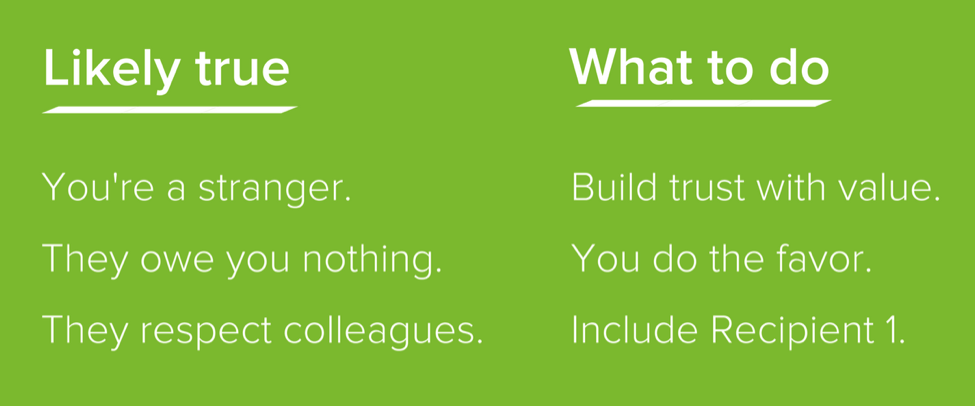
These are the steps to take with your follow up email:
- CC the colleague you first emailed to increase your chances of a reply by 12%.
- Ask yourself, what pain point does my company solve? How exactly does it solve it?
- Turn this into a problem-solution specific to your recipient’s role in his/her org.
And remember, do your homework by visiting their company site and social media to make it even more personable.
Here’s a template that one of our sales consultants uses regularly:
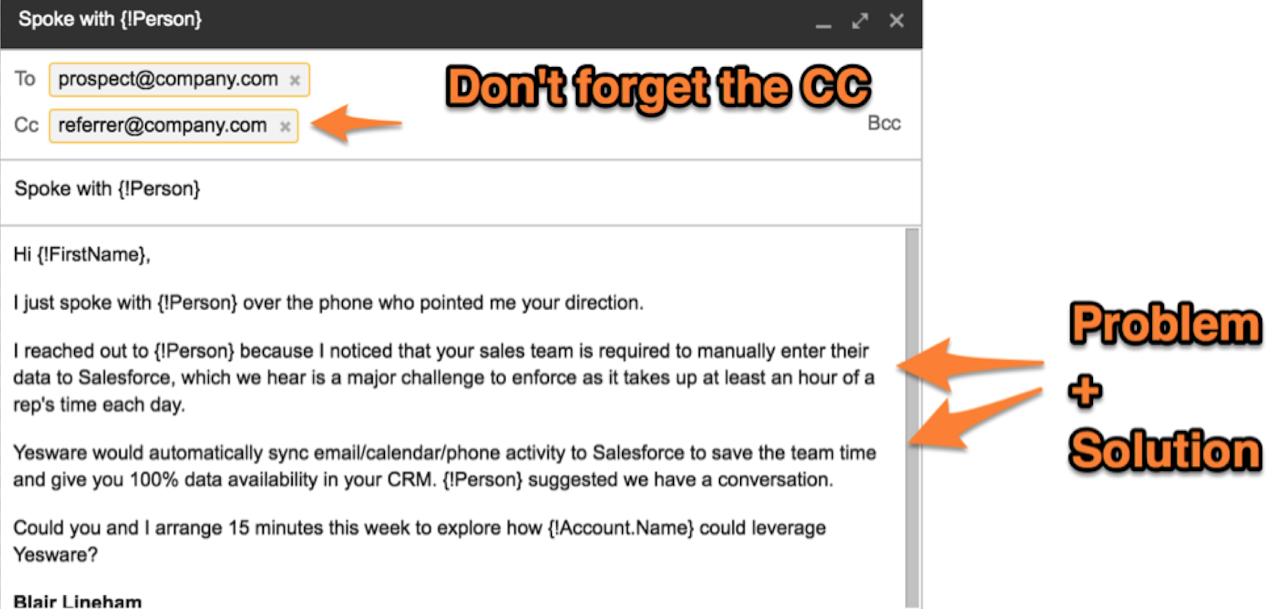
Save this follow-up email as a template:
Hi {!FirstName},
I just spoke with {!Person} over the phone who pointed me your direction.
I reached out to {!Person} because I noticed that your {!Department} team is {!Pained situation}, which we hear is a major challenge {!Why/how it’s challenging}.
{!My Company} would automatically {!Paint the solution}. {!Person} suggested we have a conversation.
Could you and I arrange 15 minutes this week to explore how {!Your Company} could leverage {!My Company}?
Pro tip: Try adding a testimonial link to your email signature. Social proof makes your company more compelling, and hyperlinks let you track clicks.
Like this:
Watch a short video to see how Acquia closes more deals, faster with Yesware.
Here are 17 other A/B testing ideas for your emails to start getting more replies.
6. When You’ve Just Had a Meeting – Keep Adding Value
Lucky you — whoever you’re emailing is invested in your relationship. They just spent their time meeting with you, and they’re probably going to read your follow-up.
But how can you go beyond opens and increase replies?
Do the work for them. Recap everything so all they do is confirm that 1) they received your email, and 2) your summary is accurate.
This is a sales meeting follow-up template that our team has great success with:
Hey {!Company Name} team,
Great meeting with you today — thank you for your time and having us {!come by the office/share in a discussion}. Look forward to reconvening on {!Agreed upon date}. Separate calendar invite to follow shortly for that.
Quick Question
Can you please reply to confirm I recapped our discussion accurately and if I missed anything?
Your Current Initiatives / Priorities / Goals:
- {!Priority 1}
- {!Priority 2}
- {!Priority 3}
Evaluation Success Criteria:
- {!Measure 1}
- {!Measure 2}
How {!My Company} Can Help:
- {!First Benefit + End Picture}
- {!Second Benefit + End Picture}
- {!Third Benefit + End Picture}
Agreed Upon Next Steps / Action Item Owners / Dates & Times:
- {!First Action + Date} — {!Owner 1}
- {!Second Action + Date} — {!Owner 2}
- {!Third Action + Date} — {!Owner 3}
7. Another Follow-Up Email Template for Adding Value
Here’s another follow-up email example for adding value right after a sales call.
This follow-up email thanks the recipient for their time and quickly recaps the call.
The template below has a 51% reply rate.
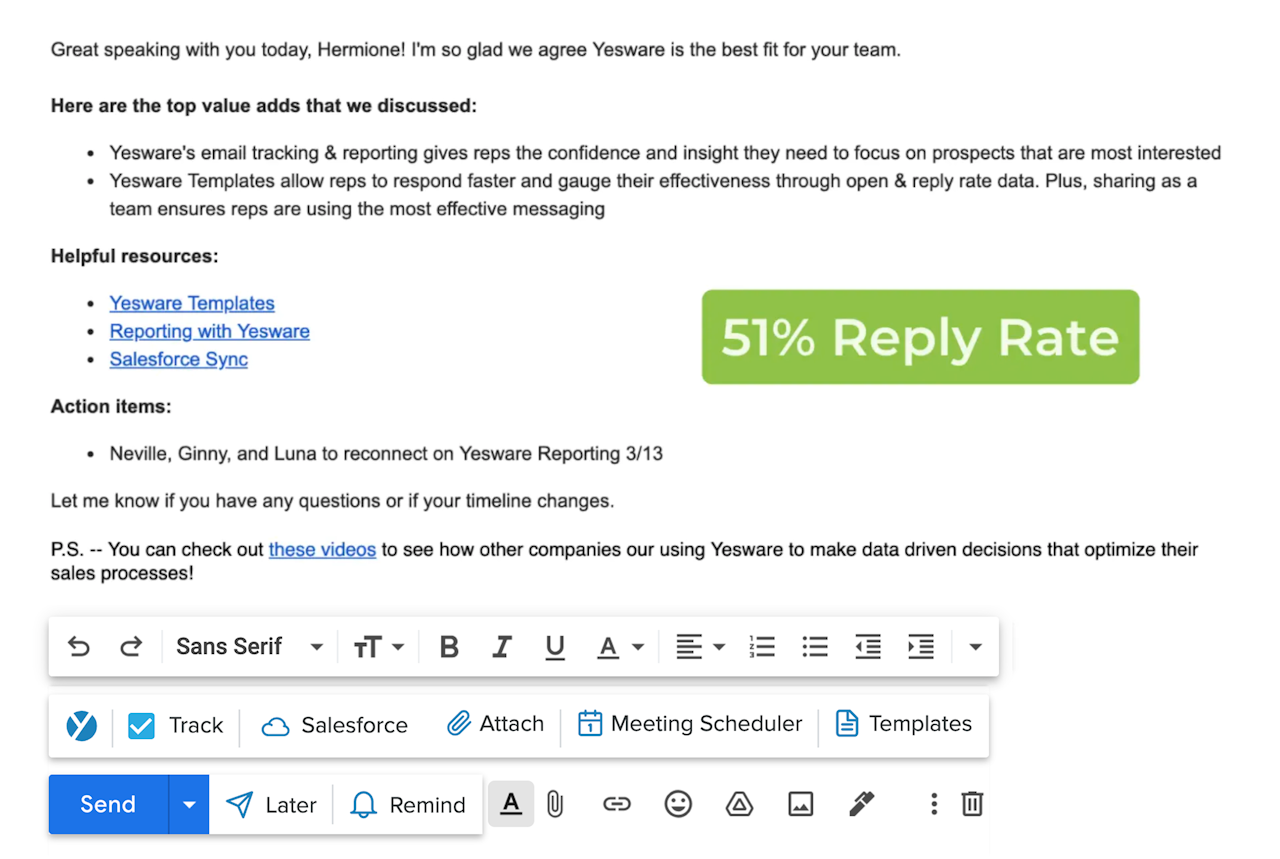
Copy and paste the follow-up email template here:
Hi {!First Name},
Great speaking with you today, {!Name(s)}! I’m so glad we agree {!Product/Solution} is the best fit for your team.
Here are the top value adds that we discussed:
- {!Value}
- {!Value}
Helpful resources:
- {!Resource}
- {!Resource}
Action items:
- {!Action Item}
- {!Action Item}
Let me know if you have any other questions or if your timeline changes.
P.S. – you can check out {insert video link} to see how other companies are using {!Product/Solution} to {!benefit/outcome}.
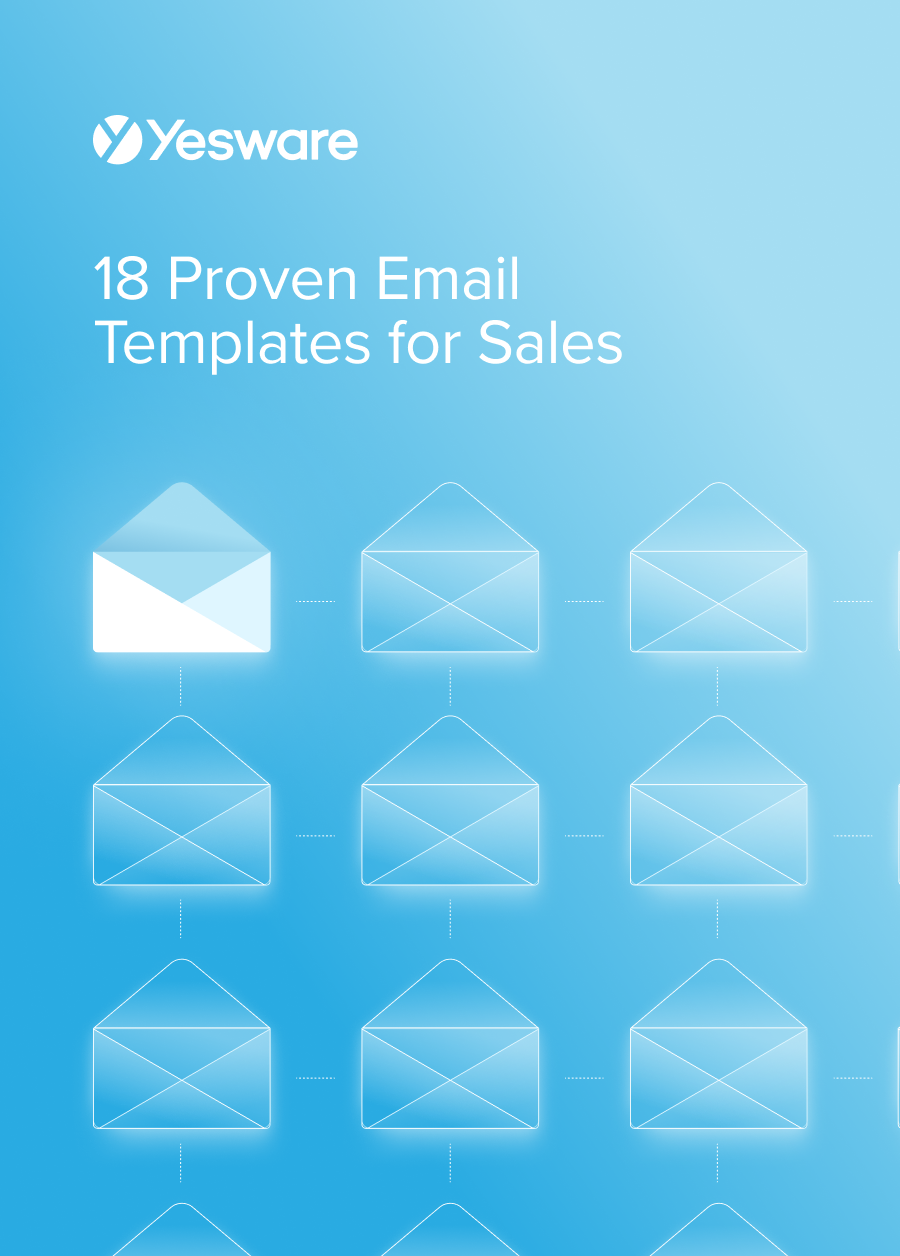 18 Proven Email Templates for SalesWinning email templates for cold outreach, follow-ups, and nurturing relationships – backed by data and real-world examples.
18 Proven Email Templates for SalesWinning email templates for cold outreach, follow-ups, and nurturing relationships – backed by data and real-world examples.
8. When You Just Left Your Interview
You just walked out of a great interview and you want to set yourself up for success.
How do you balance being polite with standing out from the rest of the candidates for the job?
Easy: take the extra 60 seconds to personalize your thank you to each person.
Two things to remember here:
- Whoever you talked to has a busy schedule. They spent their valuable time on your interview; show them it wasn’t wasted. Generic emails are careless and imply that you aren’t invested in the opportunity.
- The individuals you interviewed with are all colleagues, which means they talk. Don’t be the interviewee who blasts the same thank-you email to everyone.
How to write a follow-up email after your interview:
Personalize your email in three ways to show you were listening and you’re invested:
Paragraph 1 — Recap one point of discussion from your conversation
Paragraph 2 — Refer to their team’s relationship with your team to-be
Paragraph 3 — Mention a detail that the interviewer disclosed to you
What your email should look like
Here’s the follow-up email I sent to a sales manager I met with when I was interviewing here at Yesware:
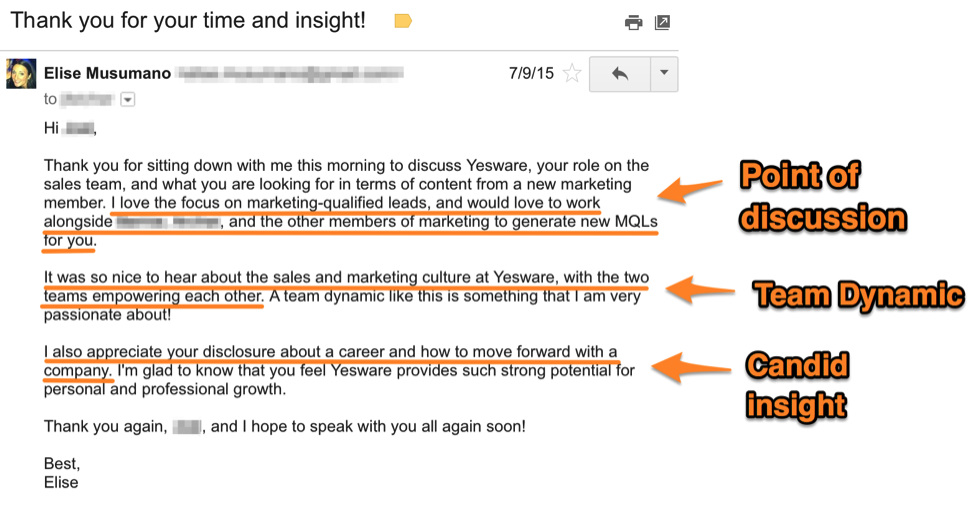
Because I took the time to send a heartfelt thank-you, I won a reply and a returned sentiment:

Here’s a copy of this email template:
Hi {First Name!},
Thank you for sitting down with me {!This morning/yesterday} to discuss {!Company}, your role on the {!Department} team, and what you are looking for from a {!Role}. I love how {!Element of company culture or role responsibilities that you discussed}.
It was so nice to hear about {!Something that aligns with your passions}. A team dynamic like this is something that I am very passionate about!
I also appreciate your disclosure about {!Another point of discussion}. I’m glad to know that you feel that {!Company} {!Something about confidence in company}.
Thank you again, {!First Name}, and I hope you again soon!
Cheers,
9. When They’re Past Due Payment (And You’re In Collections)
Make an uncomfortable situation easier with a proven collection letter template.
Here’s how to keep your email understanding but forceful:
Subject Line: Are you there, {!First Name}? Dropping a line
Hi {!First Name},
I hope this note finds you well. I want to follow up on an invoice I emailed on {!Date}. I haven’t received the payment yet, so I wanted to ensure the email isn’t lost somewhere in depths of cyberspace. Would you please check to see if the accounts payable department has received it? I’ll be happy to resend if necessary. Otherwise, I look forward to receiving payment within a week.
I really appreciate your help! Thanks!
10. When You Get a Second Shot at Your PR Pitch
Your first pitch didn’t win over the editor or reporter.
Time to up your game.
Here’s how to sell it: Keep your follow-up email shorter than your first one. Journalists spend less than one minute reading what you’ve sent them. They prefer bullet-form facts.
- Know their beat — are you reaching out to the best person? If not, identify who is and use a free tool to find their email.
- No buzzwords allowed; just include the facts.
- Offer an exclusive.
Below is an example of the first email that I sent to FastCompany (followed by my follow-up):
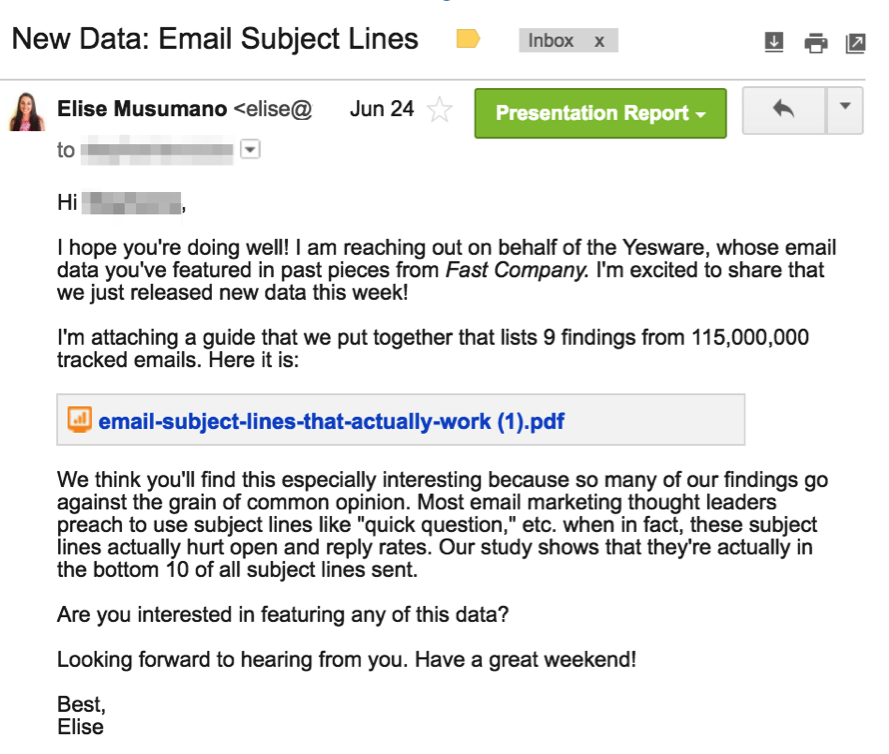
Email tracking revealed that my email was opened, but I didn’t get a reply. So here’s the follow-up email I sent three days later:
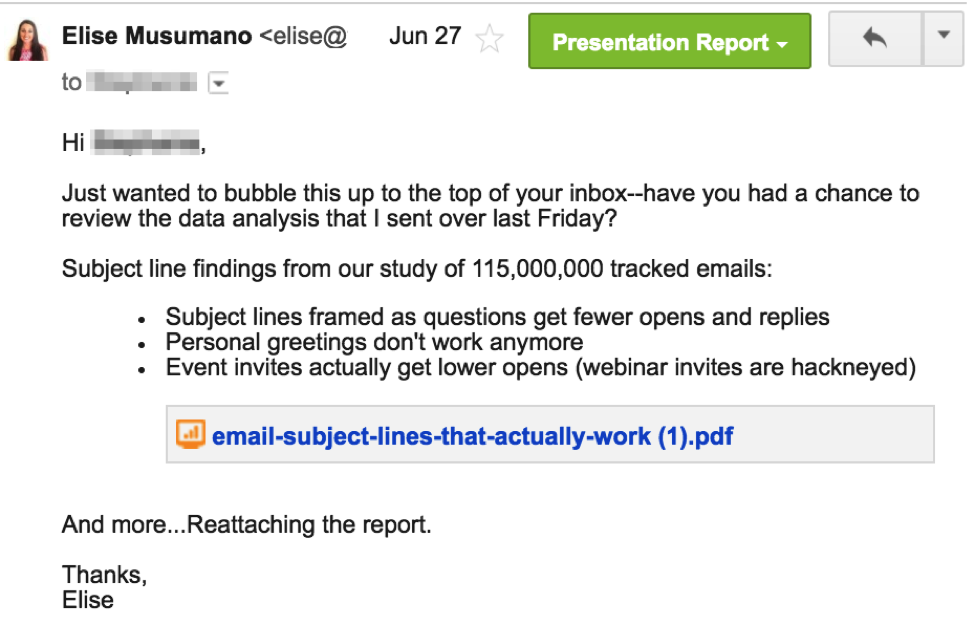
My shorter, bulleted follow-up email won the reply and placement in Fast Company.
Copy this template to re-use:
Hi {!First Name},
I know you’re busy so I wanted to reach back out about my earlier request — have you had a chance to review the {!What you sent over} that I sent over {!When you sent it}?
{!1 sentence summarizing what you have is new, comprehensive, or groundbreaking}
- {!Finding 1}
- {!Finding 2}
- {!Finding 3}
And more… Reattaching the {!Report or other source of further info}.
Thank you for your time and looking forward to your feedback,
11. The Best Follow-Up Email Template For An Inbound Lead
Are you charged with reaching out to people who download your company’s marketing content? Just because someone read something doesn’t mean they want to talk to sales (yet).
This is why you need to nurture them. How? Provide new value that shows them why you’re worth their time.
Our sales team achieves a 34% reply rate by following up with people who downloaded our recent ebook. Here’s an example of an email template that’s been filled out:
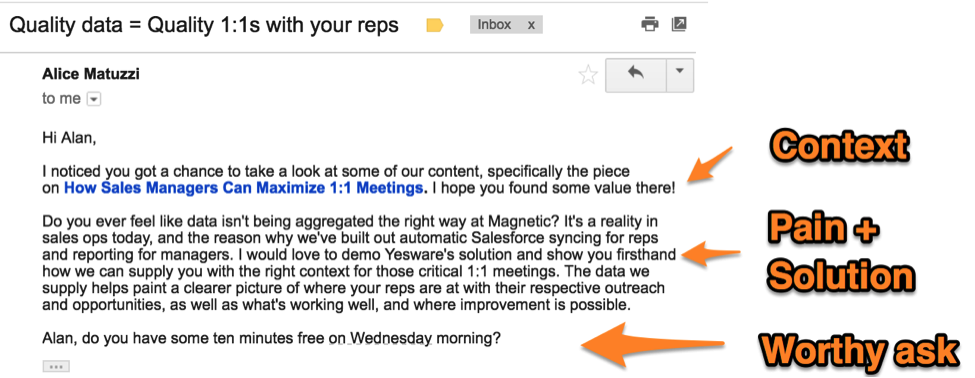
Copy this example as a template:
Hi {!First Name},
I noticed you got a chance to take a look at some of our content, specifically the piece {!Title of content}. I hope you found some value there!
{!Question triggering pain point}?It’s a reality in {!Their field} today, and the reason why {!How your company aligns}. I would love to {!action you’re looking for} {!what it accomplishes for them}. {!Statement that shows your differentiation}.
{!First name}, do you have {!amount of time} free on {!Day} {!time of day}?
12. How to Send a Follow-Up Email After No Response
Waiting for an answer from a friend, colleague, or vendor? Here’s your reality:
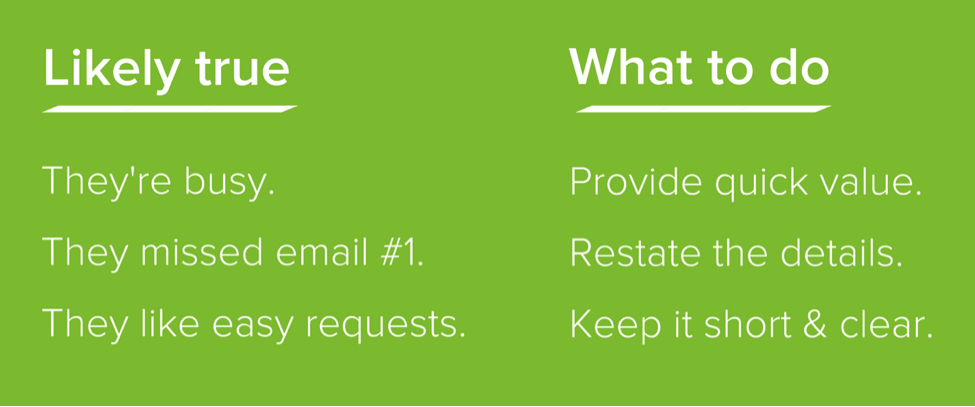
Below is a follow-up email template to send after no response. This exact email won me a 25% reply. Use it as a starting point or copy and paste the text directly here.
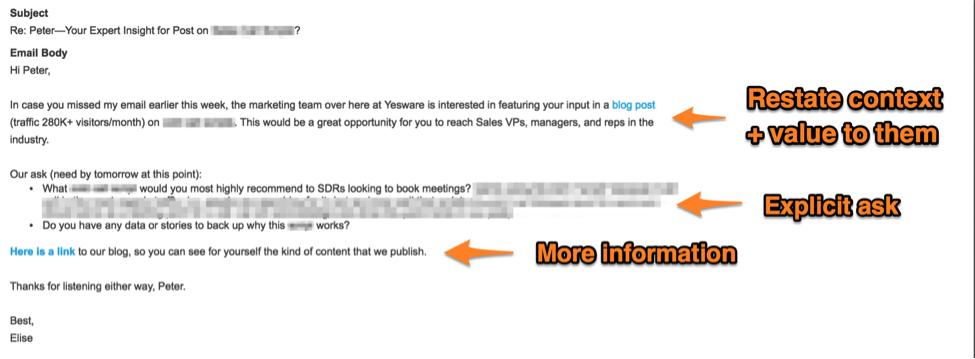
Here’s what to include in your follow-up after no response:
- Restate the context of the original email and the value to them.
- Include your explicit ask.
- More information: Any additional resources for them to review.
Here’s a template so you can re-use this follow-up email:
Hi {!First Name},
In case you missed my email {!week/day you sent it}, {!restate why you’re reaching out}. {!Value statement specific to recipient}.
My ask for you:
- {!First part of ask}
- {!Second part of ask}
{!Any additional information}.
Looking forward to your reply,
13. When They Asked You to Circle Back Later
What’s your first reaction when your alarm goes off in the morning?
Snooze — it’s how we procrastinate dealing with sales outreach, too.
Instead of taking a meeting or committing to a contract, we say, “let’s check back next quarter.”
If you’re the salesperson circling, you need to deliver tangible, relevant information.
Here’s a good follow-up email that I received after going through a demo (names changed):
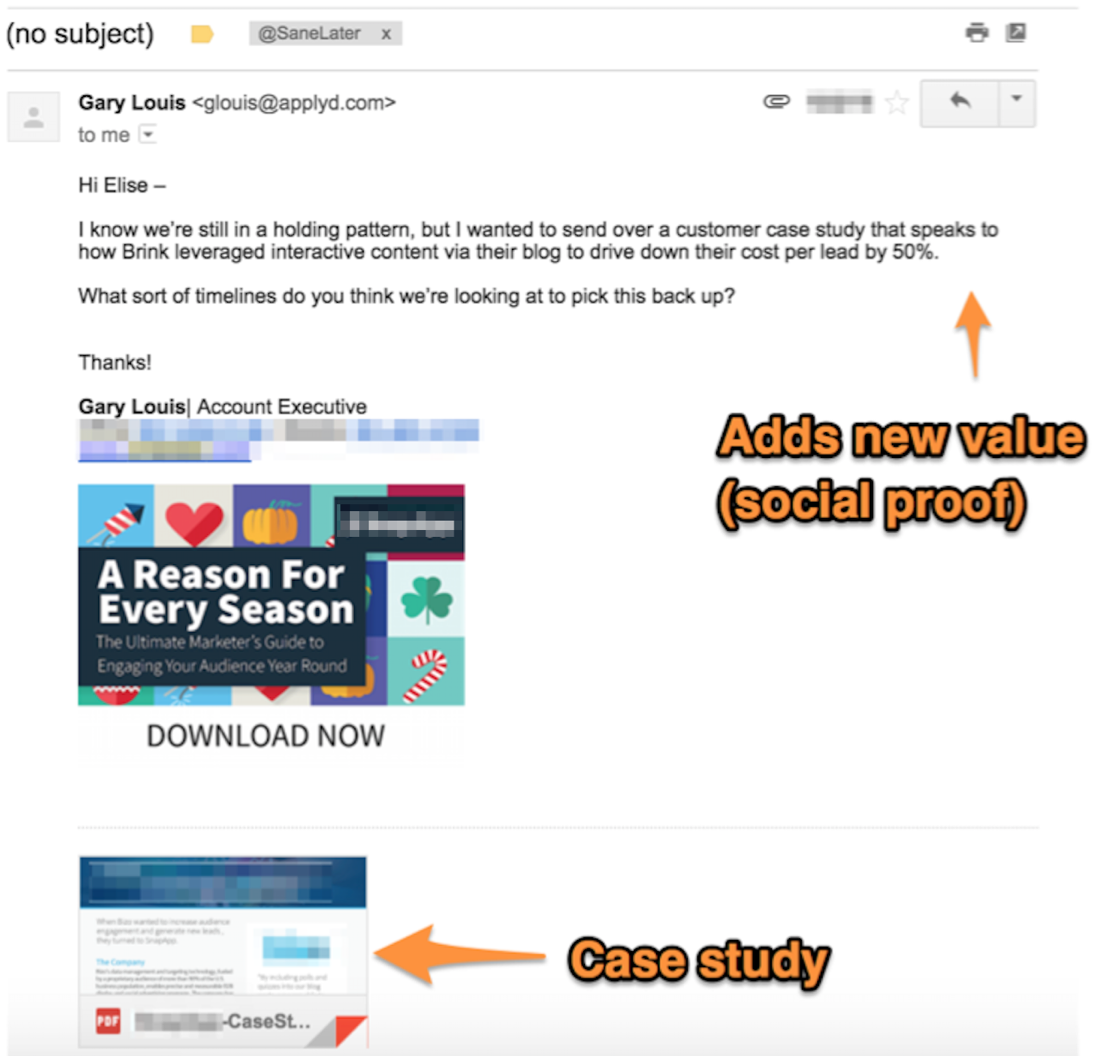
A couple of things to note here:
- Gary uses leaves the subject line empty; this is a tactic proven to increase opens.
- The case study note delivers fast value with a brand name & a success metric.
- The email signature includes a UTM-tagged ebook offer. This does two things. It nurtures prospects and it provides marketing with engagement data.
Grab the follow-up email template here:
Hi {!First Name},
I know we’re still in a holding pattern, but I wanted to send over a customer case study that speaks to how {!Customer Name} leveraged {!Product/Service} to {!What they accomplished — HARD METRIC}.
What sort of timelines do you think we’re looking at to pick this back up?
Thanks!
Pro tip: Schedule your follow-up email now to send later. Then, use tools like Google Alerts to monitor for trigger events that can help you get your foot in the door sooner. (You can always cancel your scheduled email if you find more opportune timing sooner).
14. The “Break Up” Follow-Up Email
You’ve been nurturing a ghost with a drip campaign, and it’s time to let him or her go. (The good news is you can automate the whole process so you don’t have to sit there with tissues).
Not sure how to say goodbye?
Here’s a follow-up email template that our sales team has found works best for sales break-up emails:
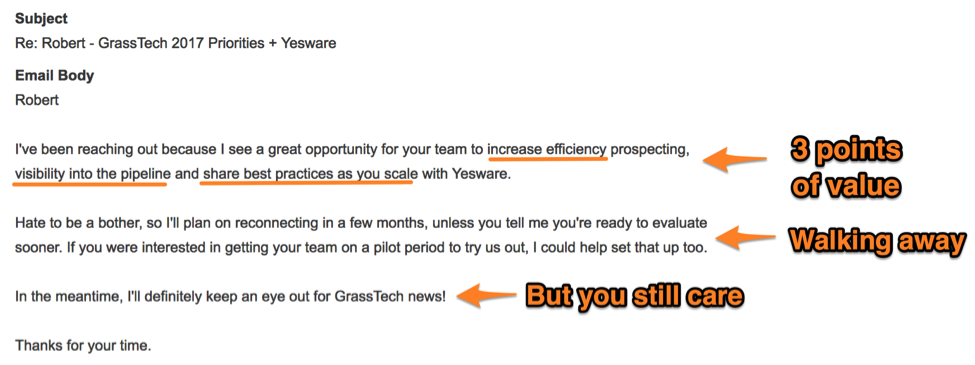
Make this template your own [copy, paste, customize]:
Hi {!First Name},
I’ve been reaching out because I see a great opportunity for your team to {!Outcome 1}, {!Outcome 2}, and {!Outcome 3}.
Hate to be a bother, so I’ll plan on reconnecting in a few months, unless you tell me you’re ready to evaluate sooner. If you were interested in getting your team on a pilot period to try us out, I could help set that up too.
In the meantime, I’ll definitely keep an eye out for {!Your company} news!
Thanks for your time.
Biggest takeaways: We dislike potential loss more than we enjoy the potential gain. This is why it’s worth telling them you’re walking away — especially if you want them to take action.
The combination of loss aversion and personalization is powerful. It drives a 33% reply rate on touch plans where this is the 5th touch.
15. Following Up After a Networking Event
If you’ve connected with a prospect at a networking event, sending a thoughtful follow-up email is essential. It’s the difference between being forgotten by your contact and striking up a long-term professional relationship.
When you follow up after a networking event, focusing on personalization is critical. After all, the idea is to build a strong relationship with your contact.
Take this template as a starting point:
Hi {!First Name},
It was great connecting with you at {!Event} on {!Date}.
I was thinking back on our conversation and what you said about {!Pain point}. I thought you might be interested in checking out this case study on how we helped {!Similar company} accomplish {!Outcome}: {Link to content}
I’d love to discuss how we can solve {!Pain point} together. Do you have time this week to jump on a 15 minute call?
Regardless, it was great meeting you and I look forward to connecting at future events.
{!Sign off}
16. Discovery Call Follow-Up Email Template
After you’ve had a discovery call with a prospect, your follow-up email is significant.
This email is a chance to reiterate your value, demonstrate that you understand their pain points, send the agreed-upon date and time for the next meeting, and, most importantly, thank them for their time. 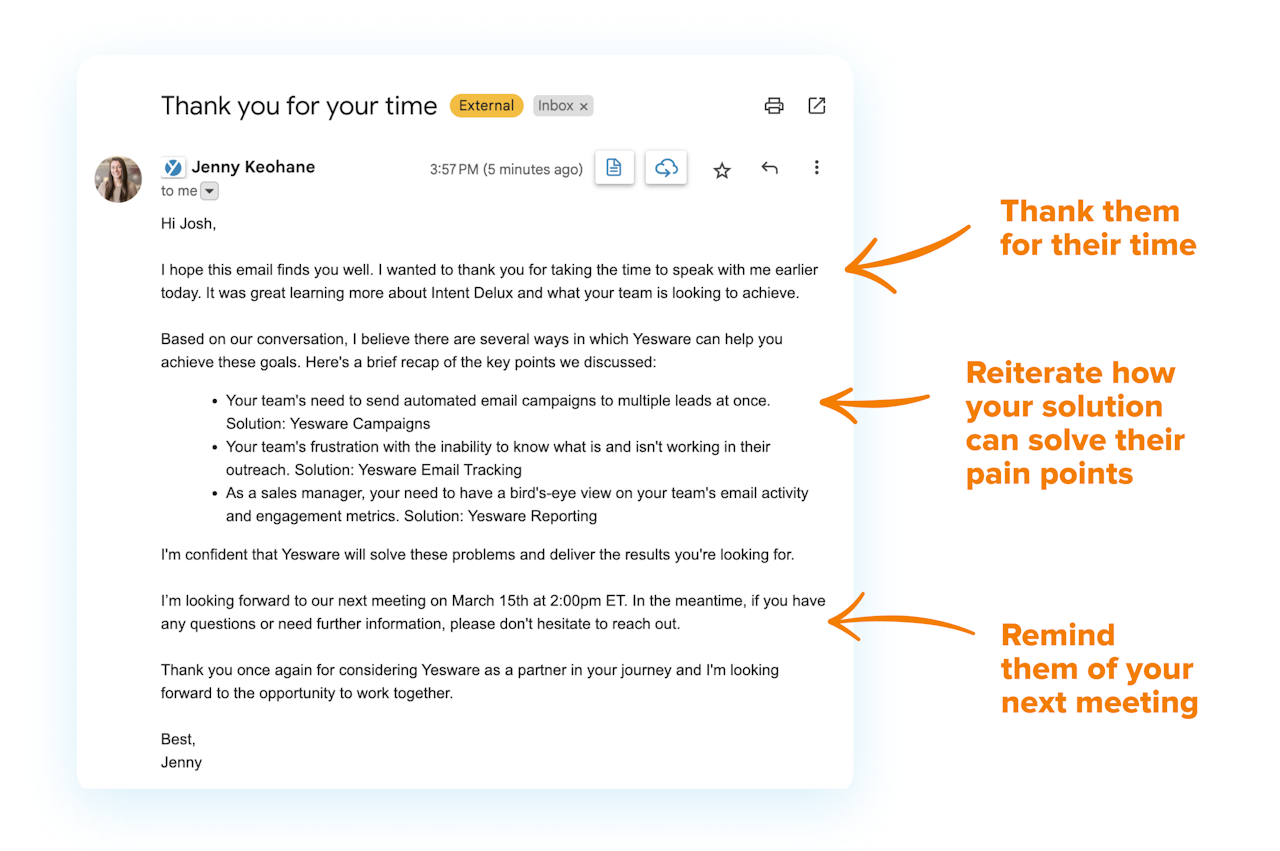
The email above demonstrates professionalism and credibility.
Grab the discovery call follow-up email template here:
Hi {!First Name},
I hope this email finds you well. I wanted to thank you for taking the time to speak with me earlier today. It was great learning more about {!Their Company} and what your team is looking to achieve.
Based on our conversation, I believe there are several ways in which {!Your Product/Service} can help you achieve these goals. Here’s a brief recap of the key points we discussed:
- {!Briefly summarize the main points of discussion, highlighting any pain points or challenges identified.}
- {!Mention the specific solutions or services your company offers that address the prospect’s needs.}
- {!If applicable, include any relevant success stories or case studies that demonstrate how your solution has helped similar clients.}
I am confident that we can tailor a solution to meet your specific requirements and deliver the results you’re looking for.
I’m looking forward to our next meeting on {!date and time}. In the meantime, if you have any questions or need further information, feel free to reach out.
Thank you once again for considering {Your Product/Service} as a partner in your journey. I’m looking forward to the opportunity to work together.
Best regards,
17. Quote Follow Up
Following up after you haven’t heard back from a quote or proposal can be that extra push the prospect needs to get things moving.
The quote follow-up email template below is a gentle reminder and encourages the recipient to respond with any questions or concerns they may have.
Remember to be direct and professional but not pushy.
Grab the quote follow-up template below:
Subject Line: Follow-Up on Your Quote from {!Your Company Name}
Hi {!First Name},
I hope this email finds you well. I wanted to follow up regarding the quote I sent over on {!date} for {!Product/Service}. I understand that you may be busy, but I wanted to ensure you received the information and have everything you need to make an informed decision.
In case you missed it, I’ve attached the quote again for your reference. Our team has put a lot of effort into tailoring a solution that meets your requirements and budget and we’re excited about the opportunity to work with you.
If you have any questions or concerns or need any modifications, please don’t hesitate to reach out. Your satisfaction is our top priority and we’re here to support you every step of the way.
Thank you again for considering {!Your Company Name} and I’m looking forward to the possibility of working together and delivering outstanding results for your business.
Warm regards,
How Do You Write a Follow-Up Email?
Every follow-up email you send is another step in a direct outreach sequence. Like your initial cold email, it has one job: to get your prospect to take action.
Studies have found that nearly 50% of responses to outreach campaigns come from follow-up emails. Put another way, you can effectively double your response rate with effective follow-ups.
Craft Compelling Subject Lines
Your subject line can make or break your email. It’s the first thing your recipient sees. And a great subject line can drive open rates of up to 87%.
The most effective subject lines accomplish two goals at once. They present a clear benefit to the reader, while also building curiosity for what’s to come in the message. Great subject lines tease the message content without giving too much away.
Check out how these top-performing subject lines did it:
- Collaborate? 👊
- We set the stage for {!Company} to be the talk of {!Location}
- {!Benefit} for {!Company}
Provide Context
Decision-makers have a lot going on. And especially if they haven’t responded to you yet, they might not remember who you are.
The last thing you want is for your prospect to get your message and think, “who’s that?”
When you start your message, make sure readers know who you are and why you’re reaching out. Refer back to your last point of contact to give context to your message.
Personalize Your Message
Now that you’ve gotten readers into your message, you want to be as relevant and personal as you can.
Prospects are real people, and they want to be treated that way. They want to see that you’ve taken the time to learn about the pain points they’re facing and demonstrate that you understand their business. By taking these steps, you begin to build a relationship and show how you could be a great partner for them in the future.
Continue to Deliver Value
Effective follow-ups don’t ask your prospect for something. They show your prospect what you can do for them.
That’s the right approach to take in your initial outreach email. And as you send follow-ups, you should continue to focus on demonstrating the value you can provide to your prospect.
One of the best ways to deliver value is by sharing content that’s relevant to your reader’s challenges.
Take a look at how the team at Freshworks nurtures leads while continuing to deliver value:
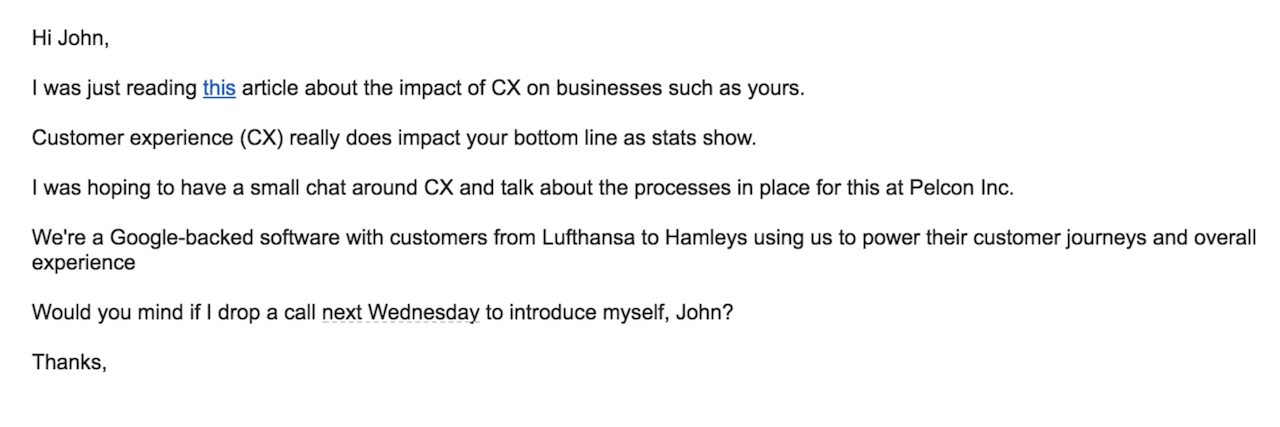
Keep It Short
Your follow-up email templates should be short.
Why?
Decision-makers are busy. And they don’t have time to read lengthy emails. If they open up your message and see a wall of text, they’ll likely move on — or worse yet, hit delete.
Keep in mind that writing short, simple emails isn’t just about brevity. It’s about readability. Take steps to make your message easy to move through quickly.
- Use lists and bullet points to make your message easily skimmable
- Put important takeaways in boldface type
- Avoid unnecessary information or detail
Make It Easy To Say Yes
As with all outreach emails, you want to make it as easy as possible for your reader to say yes. That means taking a close look at your CTA.
The close is where many outreach emails go wrong. Even if you’ve written a great subject line and a compelling message, a weak CTA will kill your reply rates.
Fortunately, keeping a few basic guidelines in mind makes it easy to write strong CTAs.
- Focus on the relationship. While it’s tempting to go for the sale right away, it isn’t effective. Prospects want to get to know you first before they commit to a deal. Start with a smaller request that moves your relationship forward, like sending a short video or getting on a quick call.
- Make a crystal-clear ask. Quite frankly, it’s hard for prospects to respond if they don’t know what you want. Avoid vague, hesitant CTAs like Let me know what you think, and be clear on the next step you want your prospect to take.
- Don’t ask for too much. Clarity is great. Putting work on your prospect is not. Making demands of your prospect’s time or effort is the quickest way to get to the trash folder. Instead, make an ask that sounds easy. Close with a simple question or share a resource your prospect can review quickly.
Now that you know what a great follow-up looks like, it’s time to think about how to create your follow-up sequence.
Planning Your Follow-Up Sequence
Since most sales deals require multiple follow-ups to get to a close, having one or two follow-up templates in your back pocket won’t cut it. You need a well-thought-out follow-up sequence you can send consistently to help move more of your prospects toward the sale.
Here’s how to plan yours.
Timing Your Sequence
Timing is critical. In most industries, it makes sense to plan a sequence with frequent touches at first, transitioning to longer intervals as time goes on.
The First Day
Since as many as 50% of buyers choose the vendor that gets back to them first, being responsive early in the sales cycle is crucial. Especially when you’re reaching out to a warm lead, you’ll typically want to send the first follow-up email within a day of your initial contact.
If you’re touching base after an initial meeting, this is a great time to send a short, simple follow-up.
The key with the first follow-up is a light touch. Consider sending a summary of your initial meeting and confirmation of next steps, or a simple note to thank your prospect for their time.
The Next Three Weeks
Over the next three weeks, continue to send regular follow-ups until you get a response.
Remember, by doing this, you’re not being annoying. You’re demonstrating that you’re a proactive, customer-focused professional — which is exactly what your prospect will typically be looking for.
At this point, the key is to strike the right balance. Following up every three to four days is a sweet spot that enables you to stay top of mind and continue to deliver value, without making your prospect feel irritated.
Staying In Touch
If you’ve sent five or six emails over a three-week span and haven’t gotten a response, you can confidently conclude that now isn’t the right time for this prospect.
Not now doesn’t mean not ever. It simply means this isn’t your prospect’s focus right now. Even if they’re not interested in moving forward now, in three months, they may be eager to have a conversation with you.
Dial back your message frequency, and continue to reach out to your prospect every few weeks. Focus on delivering value now by sharing relevant content your prospect will be interested in so that later you’ll be viewed as a knowledgeable partner when the time comes to discuss a sale.
Vary Your Send Times
One of the easiest ways to improve your follow-up email performance is to start sending emails on different days and at different times throughout the day.
Your prospects are different — and they have different routines for when they check and respond to email. If you send follow-ups consistently on Monday mornings at 10, you could be missing prospects who are frequently out of the office on Mondays or don’t check email until late in the day. Sending messages at a variety of different times gives you a better chance of reaching everyone, no matter what their schedule.
Be Consistent
For most sales professionals, the hardest thing about sending follow-up emails is simply doing it.
Let’s face it. You’ve got dozens (or hundreds) of prospects to keep up with. And getting targeted follow-ups out to all of them is a full-time job in itself.
That’s where automation is a game-changer.
With a solution like Yesware Campaigns, you can plan targeted follow-ups that go out to your prospects automatically until you get a response. Automation enables you to schedule follow-ups in advance, so they go out effortlessly while you’re having sales meetings with your most promising new prospects.
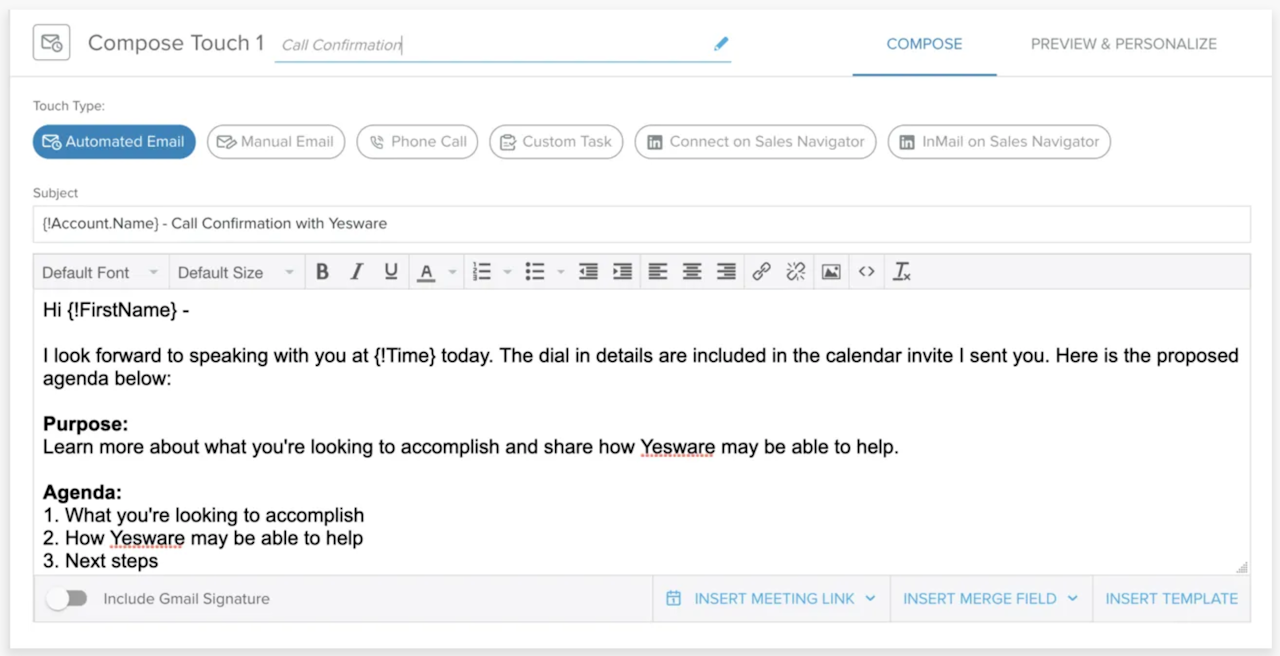
Know When To Stop
Even if you’re using automation to send targeted follow-ups at scale, you can still reach a point of diminishing returns.
Yesware’s study of follow-up emails found that after the seventh follow-up, response rates drop below 10%, making it increasingly unlikely that you’ll hear back from a prospect.
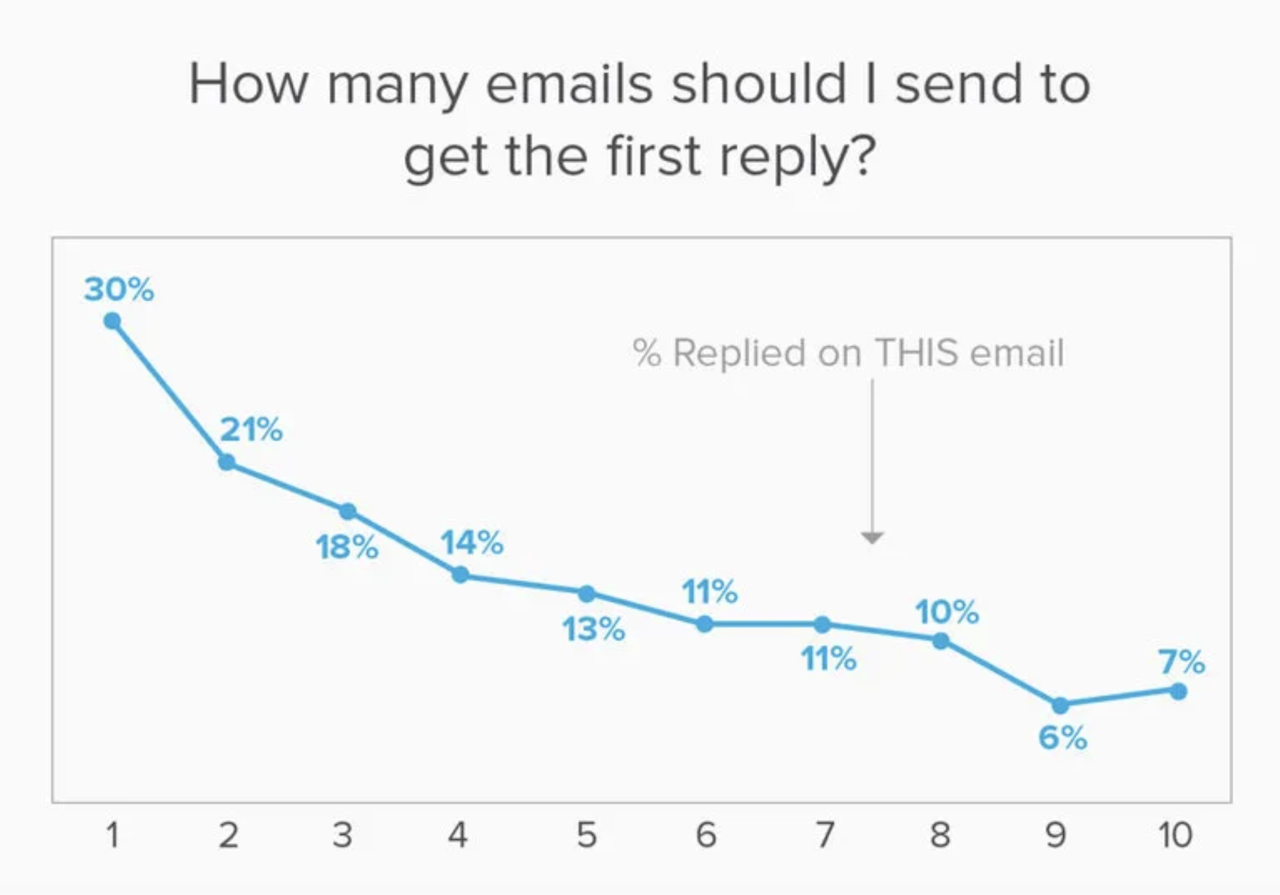
Sales experts generally agree that with completely cold prospects, a maximum of six or seven emails is reasonable. If you haven’t heard back by this point, it’s safe to assume that the prospect isn’t interested and you can move on to more engaged prospects.
With warm prospects, however, things are different. If you’ve already had contact in the past, it’s completely reasonable to continue following up as many times as you need to get a response. As long as the contact doesn’t ask you to stop reaching out, this enables you to stay top of mind with your prospect so you’re the person they go to when they’re ready for your service.
Optimizing Your Follow-Up Sequence
As you start sending the follow-up email templates above more consistently, you’ll likely start to see more responses coming in.
And what’s most exciting is that this is just the beginning.
Now is the time to take a close look at your follow-up sequence to see what’s working — and what you can improve. By taking the time to optimize your sequence, you’ll generate even more responses and drive more sales.
Getting familiar with your data is essential. With a tool like Yesware Reporting, you can view metrics for all your emails at a glance and quickly find out which templates are performing best.
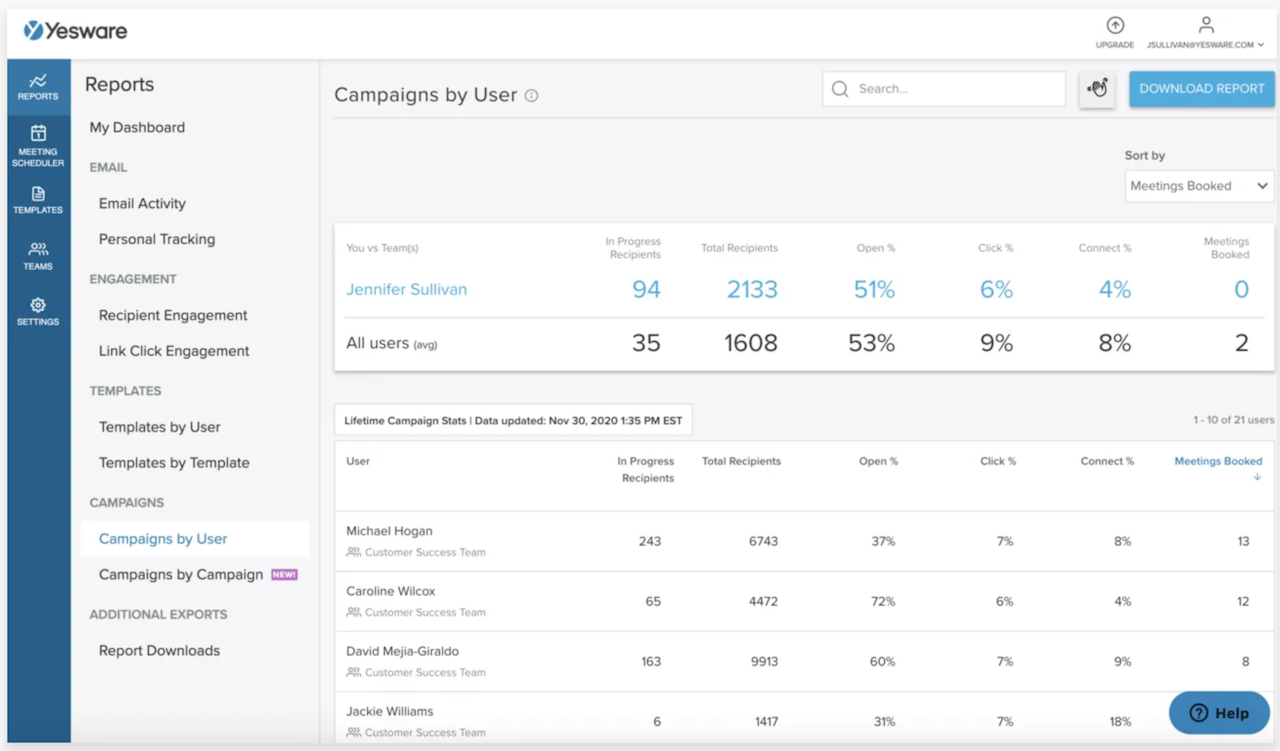
When it comes to leveling up the performance of your follow-ups, you want to focus on two key metrics: your open rates and your reply rates.
Improving Open Rates
Keep your expectations realistic. For personalized cold email campaigns, the average open rate is about 47%.
If you’re seeing low open rates, something is happening that’s preventing prospects from opening your messages. Check for common problems like these:
- Your emails aren’t reaching the prospect’s inbox. Of course, if your emails aren’t getting to the inbox, there’s no way they’ll get read. Make sure you’re using an email verification tool to confirm your prospects’ email addresses and avoid common triggers that can get your message flagged as spam. (Tip: 10 ways to find email addresses.)
- Your subject line is completely ignorable. Failing to offer value or trigger a sense of curiosity can easily cause readers to click over your email. Avoid overused, salesy subject lines like “Quick question?” which can immediately trigger resistance in your reader.
Improving Reply Rates
If your messages are being opened, but aren’t getting a response, there’s likely an issue with the body copy that’s preventing prospects from responding. Some of the most common issues include:
- Your message isn’t personalized. While follow-up messages are typically shorter and offer fewer opportunities for personalization, you should still look to customize your messages as much as possible. Something as simple as mentioning a specific pain point or sharing a relevant resource can help you stand out.
- You’re not focused on your prospect. People don’t care about you or your product. They care about themselves and their own problems. Focus your message on how you can help your reader, and resist the temptation to talk about yourself or your company.
- Your CTA is asking for too much. We’ve discussed this earlier, but it bears repeating: your entire message should make the reader’s decision smooth and hassle-free so that saying yes is a no-brainer. If your CTA sounds like it will require time or effort, you’re introducing unnecessary friction. Read your close, and be honest with yourself. Could you make a simpler ask?
Avoid These Mistakes When Writing a Follow-Up
Leaving Your Prospect in the Dark
Never leave your prospect in the dark. First, always make sure your follow-up email is on the same thread as your initial message.
And second, reiterate exactly what you’re following up about to quickly jog their memory. Keep it short and to the point — two sentences or less. For example:
Hi George — I wanted to circle back on my email below re: setting Yesware up with a free trial. Are you free for a 15 minute call this week?
Hiding Key Elements in Long Text
It’s easy to get carried away when writing follow-up emails; you’re trying to engage the prospect, stand out, and spark conversation. While all of these elements are important to incorporate in your follow-ups, make sure the text isn’t smothering the main reason behind your email.
Ensure your ask is clear so the prospect immediately knows why you’re reaching out.
You can do this by using bold words and bullet points in your emails to draw their attention to the important information.
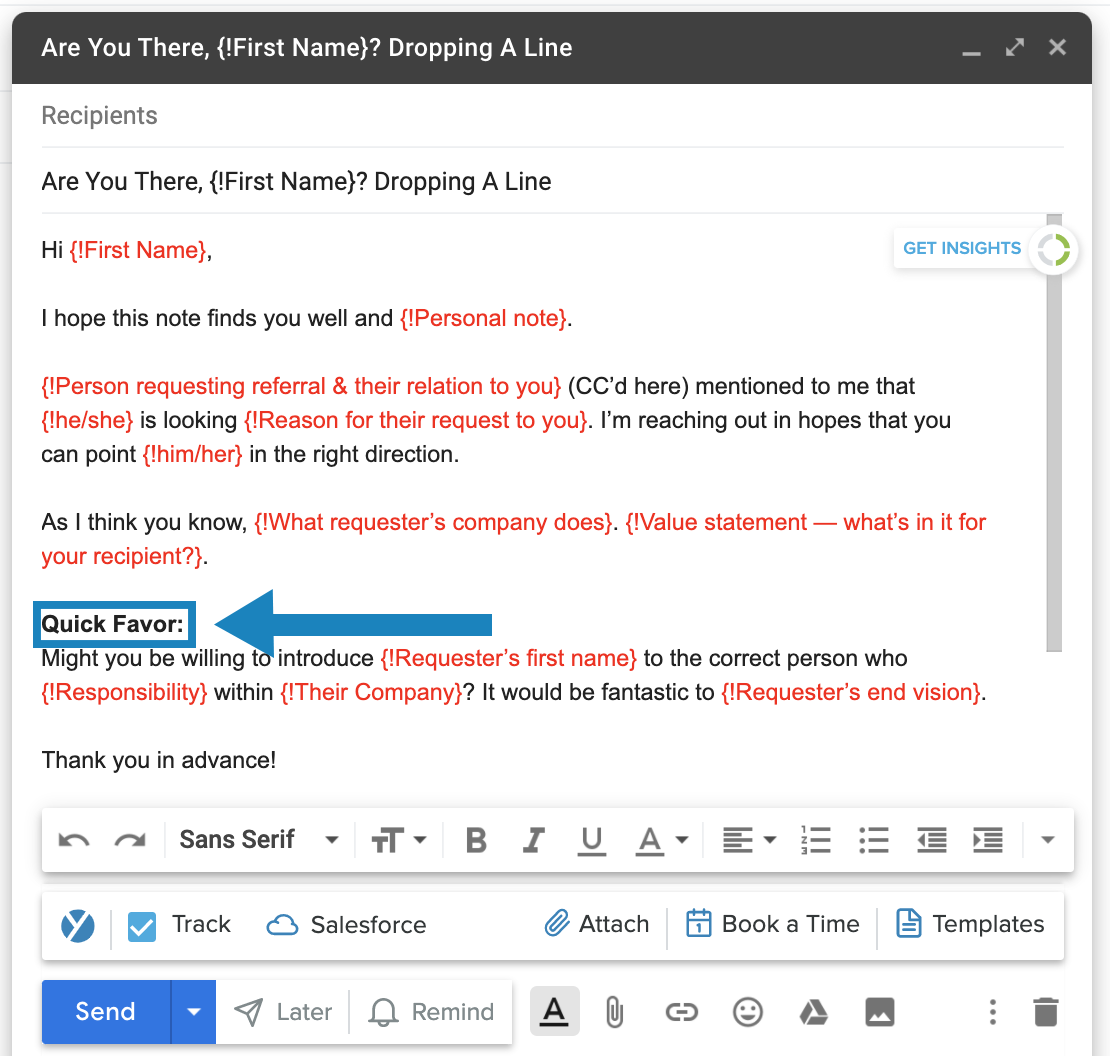
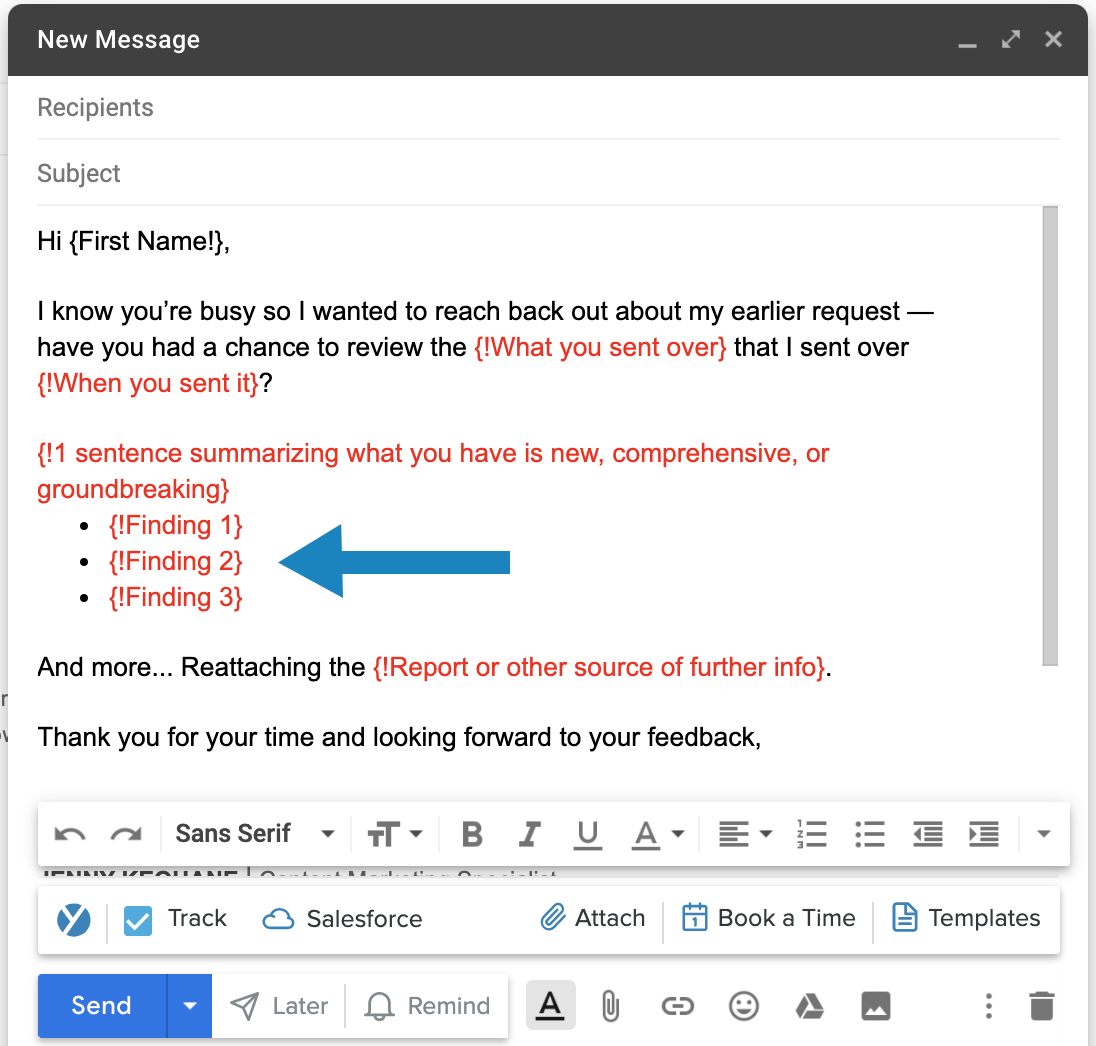
Not Using Enough Personalization in Your Follow-Ups
The most crucial mistake you can make in your follow-up emails is not personalizing your message enough. Studies consistently prove that personalized emails perform significantly better than non-personalized emails.
And no, job title and company name aren’t enough. Use unique pieces of personalization to help you stand out from the crowd and engage recipients.
Sales Follow-Up Statistics
In a recent study conducted by Yesware, we found some valuable sales follow-up statistics to help shape your strategy.
Let’s look at a couple of our favorites.
The Best Follow-Up Cadence
To find the best cadence for your follow-up strategy (number of follow-ups and time between each email), we looked at 10 million email threads sent by salespeople.
We found that the most successful follow-up cadence based on replies is approximately six touches in the span of roughly three weeks.
The chart below shows the average follow-up cadence used by reps who received replies vs. those who didn’t.
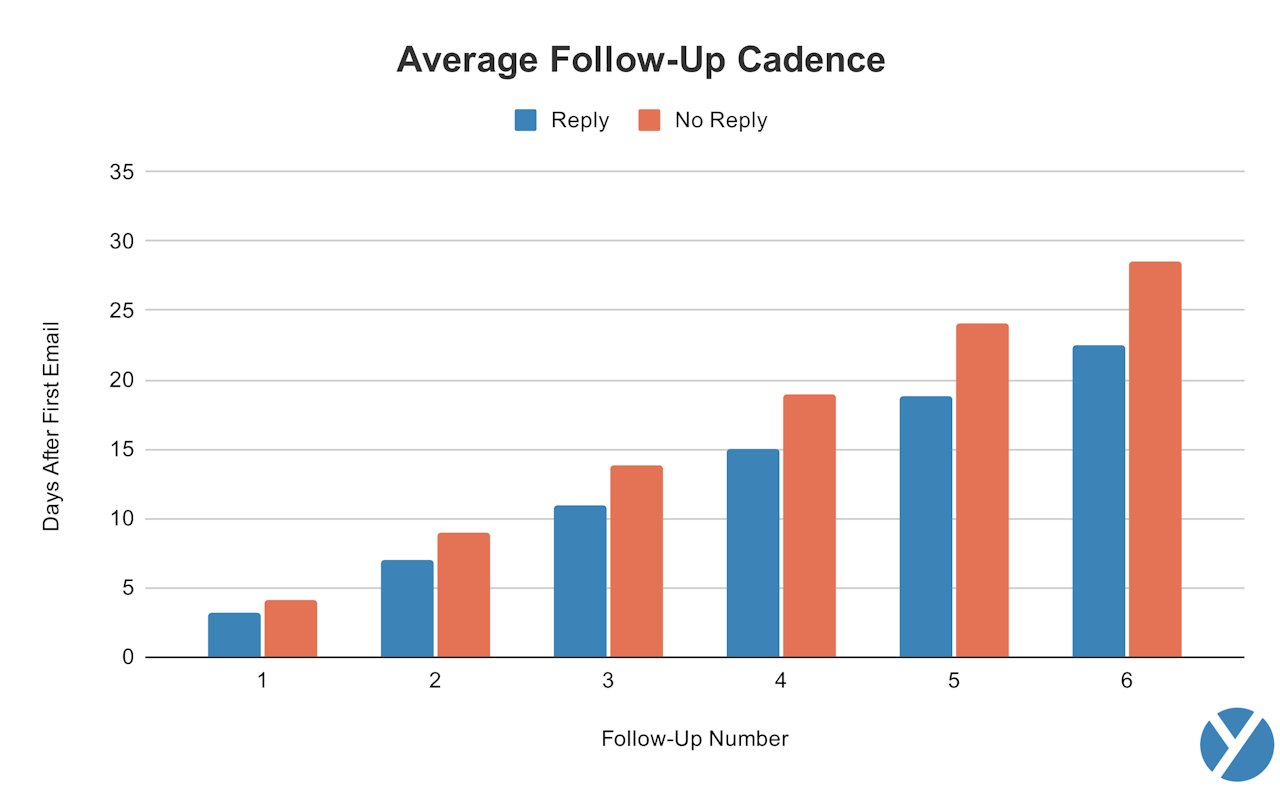 What the data tells us:
What the data tells us:
- Follow-up #1: 3 days
- Follow-up #2: 7 days
- Follow-up #3: 11 days
- Follow-up #4: 15 days
- Follow-up #5: 19 days
- Follow-up #6: 22 days
According to the data, you should spread your follow-ups out by roughly three to four days. The data also indicates that waiting more than four days typically decreases your chances of getting a reply.
When to Send Your Follow-Up Emails
We recommend you try different times for your follow-ups and measure the success of each.
But to help lead you in the right direction, this is what our data tells us about the best time to send email based on reply rates.
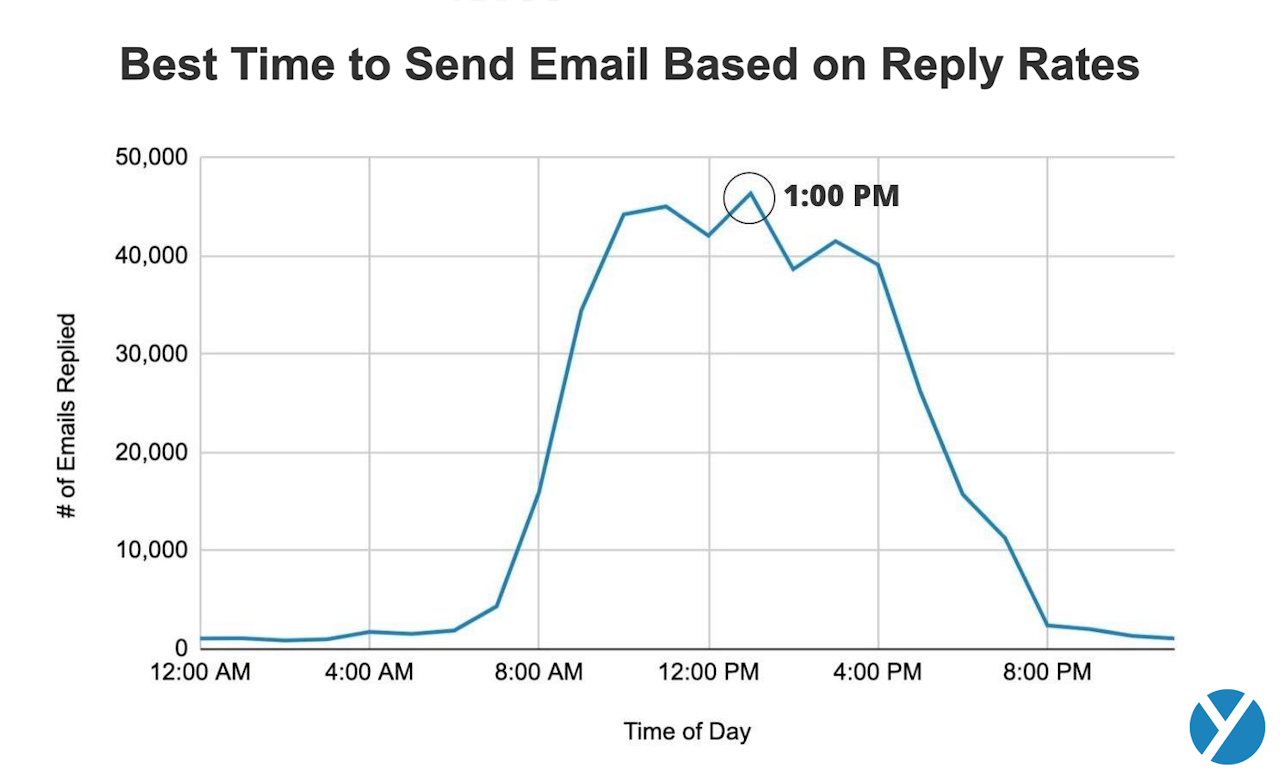
What the data tells us:
- The best time to send an is 1 PM.
- The second-best time is 11 AM.
- Low reply volume exists between the time of 8 PM-7 AM.
- There’s a sudden incline in reply volume when returning from lunch (12 PM-1 PM).
- Overall, your ideal time blocks for email outreach are 1-3 PM and 9-11 AM.
Now, take this data and test it for yourself.
Try sending your emails and follow-ups at the most active time periods and see if you get a boost in replies. Make sure to track your emails so you can see if recipients are opening your emails in the first place.
The 24-Hour Rule
One of our favorite findings from this study is that sales reps who follow up within a day see a higher reply rate.
The data indicates that sales reps who follow up within a day of their initial outreach receive about a 25% reply rate on average.
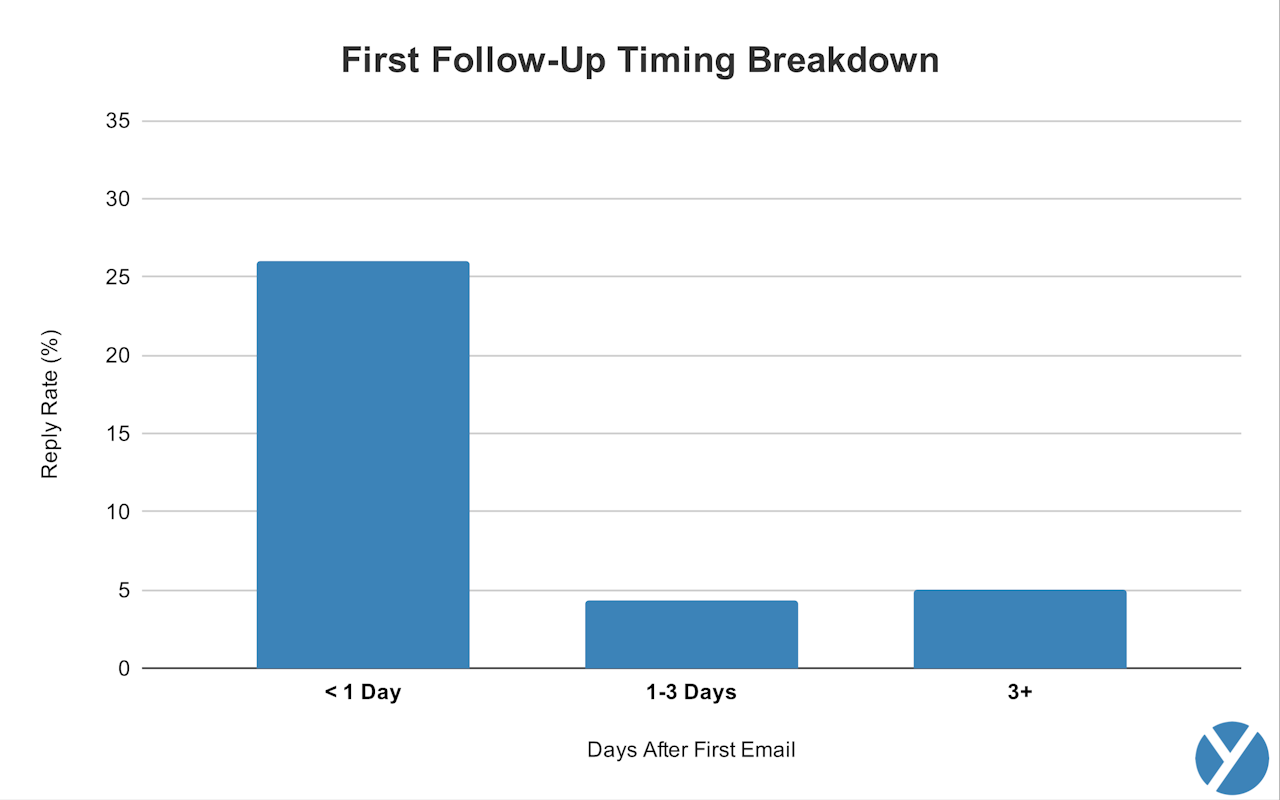
To clarify, we don’t recommend sending subsequent emails day after day. But for your first follow-up email, sending this message within 24 hours can increase your chances of getting a reply.
Conclusion
Consider what a strong follow-up game says about you.
You’re showing that you’re a proactive, customer-focused professional who’s committed to helping your prospect solve their toughest business challenges.
And by continuing to deliver value, you naturally position yourself as the person they’ll go to when they’re ready for the sale.
Take time to start building out your follow-up email templates and sequence this week — and if you already have a strategy in place, look for ways to extend and improve what you already have.
Start sending more follow-ups, and before long you’ll be amazed at the results!
This guide was updated on March 20, 2024.
Get sales tips and strategies delivered straight to your inbox.
Yesware will help you generate more sales right from your inbox. Try our Outlook add-on or Gmail Chrome extension for free, forever!
Related Articles
Yesware
Jenny Keohane
Casey O'Connor
Sales, deal management, and communication tips for your inbox
